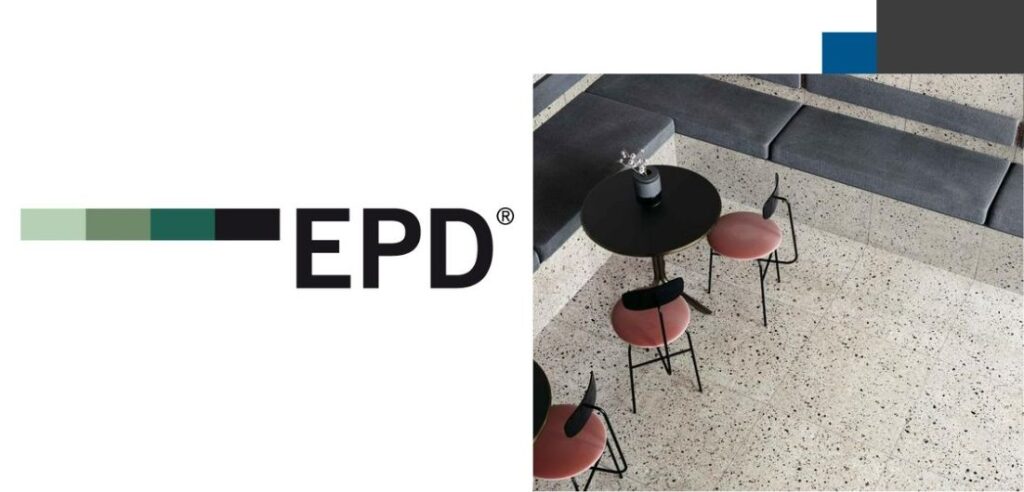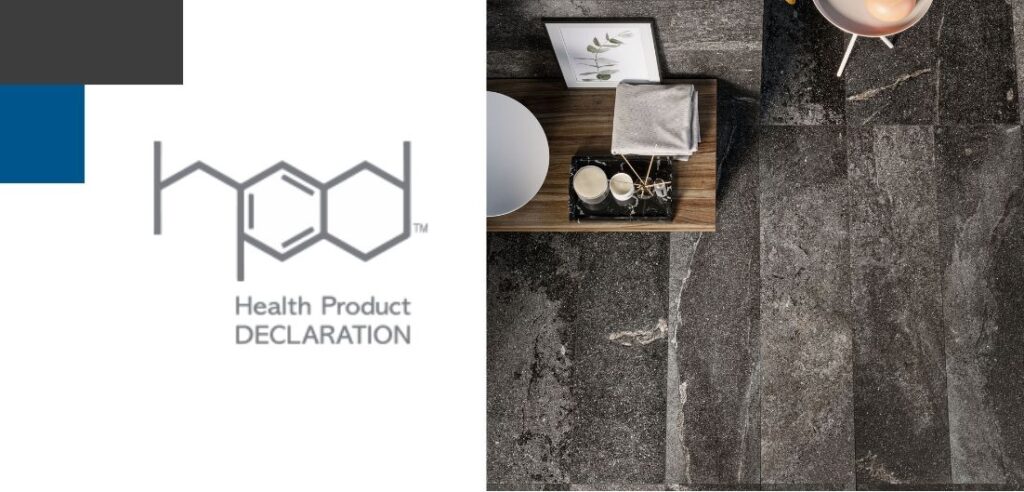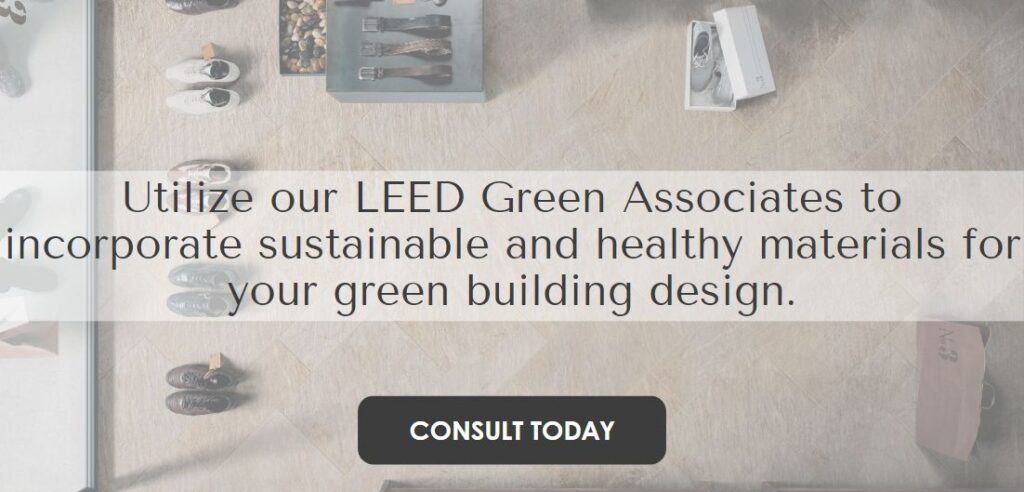
A global survey reported that 47% of executives across varying industries identify sustainability as a top priority. As these industries, which include design and construction, move toward more environmentally friendly and sustainable practices, it’s important to understand the factors considered for green commercial design.
Today, we’ll explain two essential tools in green commercial design: EPDs (Environmental Product Declarations) and HPDs (Health Product Declarations). These declarations prove crucial in promoting sustainable and healthy commercial design by providing essential information, guiding material selection, supporting green building certifications, and prioritizing occupant well-being. This comprehensive guide makes designing and specifying with green principles in mind easier.
An Environmental Product Declaration (EPD) is a standardized and independently verified document providing transparent and comparable information about the environmental impacts of a product throughout its life cycle. A life cycle assessment (LCA) evaluates the environmental performance of a product from raw material extraction to manufacturing, use, and disposal.
As a disclosure tool, EPDs provide information on a product’s environmental impact and other relevant information, including:
It’s important to note that EPDs follow standardized formats and guidelines established by international organizations like ISO (International Organization for Standardization) and CEN (European Committee for Standardization). The disclosed details in an EPD aim to provide clear, transparent, and comparable information about the environmental performance of a product, enabling informed decision-making and supporting sustainable design choices. An EPD does not mean the product meets environmental performance standards.
In conclusion, an EPD reports how a product impacts the environment throughout its lifecycle. They are conducted or verified by an approved third party to ensure correct and unbiased information. Once the EPD is finalized and approved, it is published by the International EPD System and generally remains valid for up to five years.

Many Creative Materials products possess one of two main types of EPDs that serve different purposes and cater to varying levels of specificity and granularity. Each type focuses on various aspects of a product’s environmental performance. These types include:
Generic EPDs provide average (generic) data for a specific product category. They are based on industry-wide averages or benchmarks and are not tied to any specific brand or manufacturer. These are useful when detailed data for a particular product or material is unavailable or when making early-stage design decisions. They provide a preliminary understanding of the environmental impacts of a product category, allowing for comparative analysis and screening of different options.
Product-specific EPDs provide comprehensive information about the environmental impacts of a specific product. They are the most common type of EPD and are typically developed for individual products or materials, such as concrete, steel, insulation materials, or flooring systems. Product-specific EPDs offer detailed data on the product’s life cycle assessment (LCA) results, including information on energy consumption, carbon emissions, water usage, and other environmental impact categories.
An HPD is a standardized and publicly disclosed document that provides transparent information about the potential health impacts of building products. It focuses specifically on a product’s material contents and associated health hazards. The HPD is intended to assist architects, designers, and building professionals in making informed decisions about selecting materials promoting occupant health and well-being.
The key features of an HPD include:
The HPD complements other sustainability and health-related tools in green building design, such as EPDs (Environmental Product Declarations) and green building certifications like LEED (Leadership in Energy and Environmental Design) and WELL Building Standard. These tools help professionals select materials and products, prioritizing environmental sustainability and occupant health and well-being.

There are two primary types of HPD available: Full and Simplified. Creative Materials products possess a Full HPD.
A Full HPD provides comprehensive information about a building product’s ingredients and potential health hazards. It discloses the product’s chemical composition, including intentionally added substances and known contaminants or impurities. This type of HPD offers the most detailed information, enabling architects, designers, and building professionals to assess the potential health risks associated with the product.
A Simplified HPD provides a condensed version of the HPD, focusing on critical health-related information. It highlights known hazardous ingredients and potential health hazards while presenting the information in a more simplified and user-friendly format. Simplified HPDs are intended to provide an overview of the health impacts of a product in a more digestible manner, allowing for quick comparisons and assessments.
While both are standardized and publicly disclosed documents, the table below outlines the focus, information provided, and purpose of each, helping to identify key similarities and differences:

By incorporating EPDs and HPDs into the decision-making process, professionals can consider the entire lifecycle of building materials and products. This enables informed choices regarding material sourcing, resource efficiency, and end-of-life considerations. Ultimately, this supports the transition to a circular economy by minimizing waste, promoting the reuse of materials, and reducing the overall environmental impact of commercial buildings.
Designing for durability with consideration of a product’s lifecycle can be as important as functionality and aesthetics. Porcelain and ceramic tiles have emerged as frontrunners in this regard, offering an array of advantages that make them an excellent choice for commercial flooring projects. With benefits spanning from initial installation expenses to maintenance and more, the lifecycle analysis of porcelain and ceramic tiles proves exceptional value throughout their extended lifespans. Opting for these products delivers aesthetically pleasing and durable options and ensures maximum return on investment while minimizing long-term financial outlays.
Absolutely. LEED (Leadership in Energy and Environmental Design) Green Associates from Creative Materials are well-equipped to guide you through the complexities of product selection and product declarations while ensuring compliance with industry standards and best practices. Here’s how they assist:
In the Novartis Case Study, a prominent project pursuing LEED certification, Creative Materials collaborated closely with the project partners to identify the ideal solution to meet the LEED requirements and the project’s design objectives. Through a thorough evaluation process, Creative Materials determined that Mosa, a renowned manufacturer of Cradle to Cradle Certified® Gold tiles, was the best option for the project. Mosa’s tiles aligned perfectly with the desired LEED goals and met the project’s aesthetic and performance criteria. This successful collaboration exemplifies Creative Materials’ commitment to delivering innovative and sustainable solutions tailored to each project’s unique needs. Trust our LEED Certified Consultants from Creative Materials to guide you through the intricate landscape of products and their accompanying declarations for commercial design. Together, we will create sustainable and healthy environments that promote well-being and contribute to a greener future.
